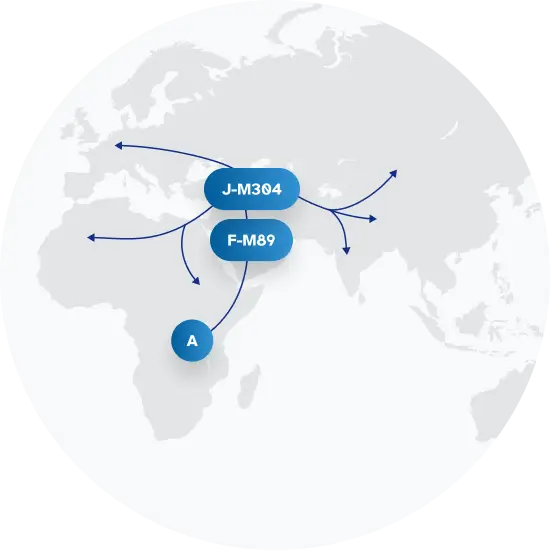Explore the Family Name Newcomer
How common is the last name Newcomer in the United States?
Based on the Decennial U.S. Census, the surname 'Newcomer' saw a slight decrease in popularity between 2000 and 2010. Initially ranked at 6088 in 2000, it slipped to 6449 in 2010, a change of about -5.93%. Despite the decline in rank, the count of the Newcomer surname increased by 1.19%, from 5201 in 2000 to 5263 in 2010. The proportion per 100k people also decreased by 7.77% during this period.
| 2000 | 2010 | Change | |
|---|---|---|---|
| Rank | #6,088 | #6,449 | -5.93% |
| Count | 5,201 | 5,263 | 1.19% |
| Proportion per 100k | 1.93 | 1.78 | -7.77% |
Race and Ethnicity of people with the last name Newcomer
In terms of ethnicity, the data from the Decennial U.S. Census indicates some changes for those with the surname 'Newcomer'. The percentage of individuals identifying as White decreased slightly from 96.81% in 2000 to 94.83% in 2010. However, the Hispanic population increased significantly by 185.92%, even though they still represent a small fraction of the total. There were minor increases in the Asian/Pacific Islander, Two or more races, Black, and American Indian and Alaskan Native categories. Notably, there was a significant 41.03% increase in those identifying as two or more races, while the Black population saw a modest 20% rise.
| 2000 | 2010 | Change | |
|---|---|---|---|
| White | 96.81% | 94.83% | -2.05% |
| Hispanic | 0.71% | 2.03% | 185.92% |
| Two or More Races | 1.17% | 1.65% | 41.03% |
| Asian/Pacific Islander | 0.73% | 0.78% | 6.85% |
| American Indian and Alaskan Native | 0.33% | 0.4% | 21.21% |
| Black | 0.25% | 0.3% | 20% |
Newcomer ancestry composition
23andMe computes an ancestry breakdown for each customer. People may have ancestry from just one population or they may have ancestry from several populations. The most commonly-observed ancestry found in people with the surname Newcomer is British & Irish, which comprises 42.4% of all ancestry found in people with the surname. The next two most common ancestries are French & German (39.1%) and Eastern European (3.8%). Additional ancestries include Scandinavian, Italian, Ashkenazi Jewish, Spanish & Portuguese, and Indigenous American.
Ready to learn more about your ancestry? Get the most comprehensive ancestry breakdown on the market by taking our DNA test. Shop 23andMe
| ANCESTRY BREAKDOWN | COMPOSITION |
|---|---|
| British & Irish | 42.4% |
| French & German | 39.1% |
| Eastern European | 3.8% |
| Other | 14.6% |

Possible origins of the surname Newcomer
Your DNA provides clues about where your recent ancestors may have lived. Having many distant relatives in the same location suggests that you may all share common ancestry there. Locations with many distant relatives can also be places where people have migrated recently, such as large cities. If a large number of individuals who share your surname have distant relatives in a specific area, it could indicate a connection between your surname and that location, stemming from either recent ancestral ties or migration.
Based on 23andMe data, people with last name Newcomer have recent ancestry locations in the United Kingdom of Great Britain and Northern Ireland and Ireland.
| RECENT ANCESTRY Location | Percentage |
|---|---|
| Greater London, United Kingdom | 86.50% |
| Glasgow City, United Kingdom | 85.80% |
| West Midlands, United Kingdom | 85.10% |
| Merseyside, United Kingdom | 85.10% |
| Greater Manchester, United Kingdom | 85.10% |
What Newcomer haplogroups can tell you
Haplogroups are genetic population groups that share a common ancestor on either your paternal or maternal line. These paternal and maternal haplogroups shed light on your genetic ancestry and help tell the story of your family.
The top paternal haplogroup of people with the surname Newcomer is J-Z631, which is predominantly found among people with European ancestry. Haplogroup J-Z631 is descended from haplogroup J-M304. Other common haplogroups include R-M405 and J-M241, which are predominantly found among people with European and European ancestry. Other surnames with similar common haplogroups are: Worden, Rood, Fuqua, Burchfield, Langston, Rude, Hamlett, Joubert, Wieland, Pleasant.
The most common maternal haplogroups of people with Newcomer surname are: H1, N, H. These most commonly trace back to individuals of European ancestry.
 Paternal Haplogroup Origins J-M304
Paternal Haplogroup Origins J-M304Your maternal lineage may be linked to the nomadic Tuareg of the Sahara
Though haplogroup H1 rarely reaches high frequencies beyond western Europe, over 60% of eastern Tuareg in Libya belong to haplogroup H1. The Tuareg call themselves the Imazghan, meaning “free people.” They are an isolated, semi-nomadic people who inhabit the West-Central Sahara and are known today for a distinctive dark blue turban worn by the men, and for their long history as gatekeepers of the desert.How did women carrying H1 make it all the way from western Europe to this isolated community? They likely migrated from Spain across the Strait of Gibraltar into Morocco after the Last Ice Age, where they were assimilated into the Berbers of the Mediterranean coast. Then, about 5,000 years ago, the Sahara shifted from a period of relative habitable conditions to its dramatically arid desert environment. This shift may have caused migrations throughout the Sahara, prompting the ancient Tuaregs to meet and mingle with the Berbers, bringing H1 lineages into their population.

What do people with the surname Newcomer have in common?
Spoiler alert: it's complicated. People with the same last name are usually no more genetically similar than a randomly sampled group of people from the same population. That said, people with the same surname are more likely to have similar ancestries than randomly sampled individuals. The reason is the tendency of people with similar cultural or geographical backgrounds to preferentially mate with one another. That's why people who share a surname may be more likely to share traits and tendencies in common than people within the general population. Check out the percentages below to see the prevalences of tastes, habits, and traits of people with your surname compared with prevalences among 23andMe users.
Preferences
Traits
Habits
Wellness
Are health conditions linked to the last name Newcomer?
The short answer is that, if there is an association between surname and health, it's usually more about your ancestry than your name. Individuals with a given surname are no more genetically similar than the general population but often have similar ancestries. The populations of people associated with those shared ancestries often have sets of genetic variations, also known as alleles, in common. Some of those alleles are associated with a greater likelihood of developing certain diseases.
Disease variant frequency by ancestry
Disease allele frequencies in populations associated with the surname Newcomer are shown below. Important Note: not everyone with a disease allele will develop these health condition





















